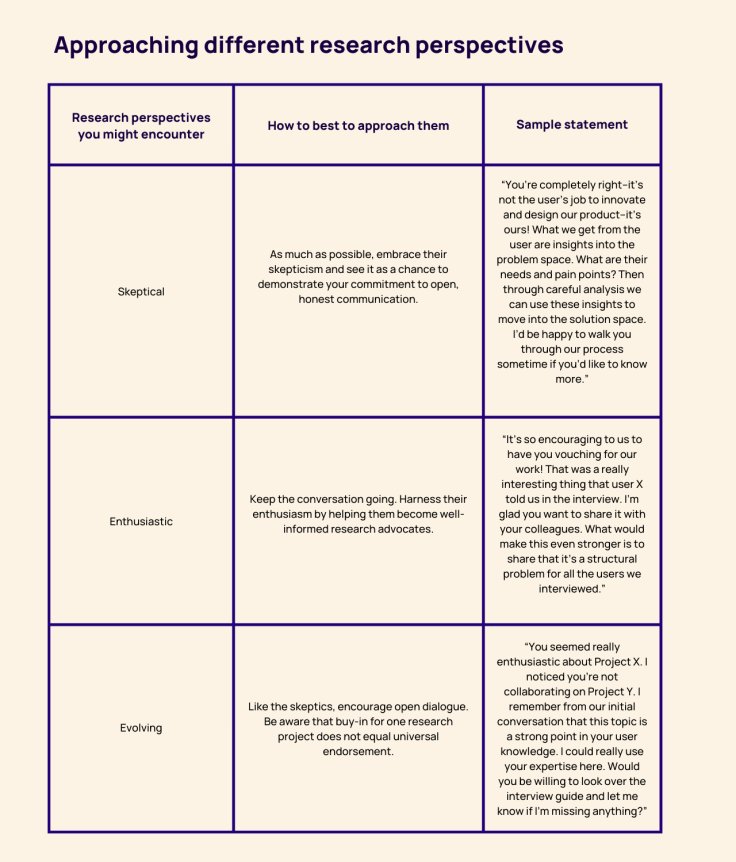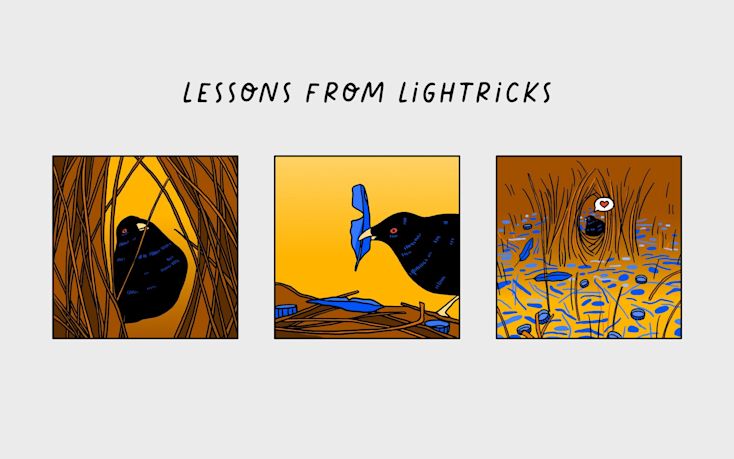How to uncover stakeholder perspectives on research: Part one

The dirty secret about UX research is this: The job isn’t just about understanding your users. The job is about understanding your stakeholder’s views toward users and then communicating research insights to your stakeholders in the most fitting way. This is essential so that they, not just you, have a comprehensive understanding of the user experience and factor these insights into decision-making.
In essence: It doesn’t matter how great of a researcher you are, or how deeply you, personally, understand the needs and pain points of your users. If your stakeholders don’t absorb these insights and apply them to their decision-making, your work will not have impact.
There are a lot of ways to approach this challenge. One example is to find best practices to communicate to stakeholders. Outlier has a great article (interviewing their own Head of Product!) about how to share the value of research to leadership, for example by relating your insights directly to decision making and ROI.
Another important step along the way is assessing the UXR maturity of your organization. Not every company is the same and maturity levels vary. Method in Madness has another article that’s key to evaluating and growing UXR maturity at your company.
But let’s go back to the heart of the challenge: to build a successful research practice, you must deeply understand the perspectives your key stakeholders hold toward their users and toward UX research. Just as UXR maturity varies between organizations, so do perspectives.
The starting point for uncovering these perspectives is interviewing key stakeholders, preferably on an individual basis. The interviews should be semi-structured in nature and consist of the following key questions:
Can you please describe your role and responsibilities? (If the interviewing is with a PM or PO, for example, make sure to use this opportunity to get to know their view on the product(s) for which they are responsible)
What types of interactions do you currently have with the users? (the goal here is to uncover the status quo)
As UX researchers, what can we do to help improve your understanding of the users? (This question will give an indication of how this stakeholder views research as a discipline)
Let’s talk about some common perspectives you may encounter and how you can best address them.
A few key perspectives you may encounter from your non-research stakeholders
I’ve led UX research at digital product companies, both as a founding lead and as a manager upskilling and growing an existing research team. A key part of these roles was getting to know my major stakeholders—primarily product managers or product owners—most of whom did not have a background in research. I knew I needed to understand their perspectives quickly before I could dive into research practice.
Understanding your stakeholders is key to success in any job. As I discussed in an earlier article this is part of looking inward, to understand the existing company mindset toward users and insights-driven decision making.
In my experience, we did this through a combination of stakeholder interviewing and observation, which I’ll detail more in a later article. Through the initial stages of getting to know our stakeholders, we were able to identify a number of perspectives. This will vary per organization, and naturally there can be overlap between them. That said, here are some general perspectives to watch out for:
Skeptical perspectives toward research. These stakeholders may see research as unnecessary. They view deep understanding of the user as essential to their product leadership role, so why would another person need to do this for them? These stakeholders may also view talking to users as a barrier to innovation. They believe their responsibility is to innovate the product—not ask others how to do it. They do not see how speaking to users could assist in this process.
Enthusiastic perspectives toward research. UX research? Yes, please! These stakeholders are eager to collaborate with UX researchers and are thirsty for user insights that can help them with decision-making. They actively encourage the rest of the organization to interact more with users and champion insights sharing after getting the results of a recent project. At the same time, their actual knowledge about the practice of research may vary.
Evolving perspectives toward research. Falling somewhere in between skeptical and enthusiastic perspectives, these stakeholders see the value of research but are still figuring out how it can best help them in their role. In some cases, they want insights to assist them in their decision-making. In other cases, they still see their own intuition as the best way forward. They want to hear the user perspective but may resist it at certain points in time.

How to address these perspectives in order to set your research practice up for success
Don’t be fooled into thinking that one of these perspectives is easier to deal with than the others. Here’s an example: the most skeptical stakeholder I’ve worked with told us right from the start how unconvinced they felt about our role. This was terrifying to be honest—to come into a job and hear someone in a position of power tell you, directly, that they don’t see value in collaborating. It did, in fact, turn out this way: this was not someone we ended up working with closely.
However, this particular stakeholder was actually a blessing in disguise. They gave us the gift of their honesty. All we could do in this situation was thank them for being straightforward. If they raised their hand in meetings, we called on them right away and engaged their concerns as best we could. This may not have changed their mind, but it did demonstrate to the rest of our colleagues that the UX researchers valued open dialogue. In addition, stakeholders who are willing to voice skepticism will force you to up your game—you’ll need to justify your approach, usually with more detail than you would with enthusiasts. This will make you a stronger researcher, even if you find their perspectives hard to deal with.
Perhaps surprisingly, enthusiastic stakeholders can also be a challenge. Sometimes, enthusiasm does not equal insight into how the research process actually works. Imagine this scenario: A stakeholder who professes a great love for research accompanies you on a user interview. That user shares some concerns that the stakeholder hasn’t heard before. This is an exciting moment! The stakeholder proceeds to share that user’s perspective far and wide, and even begins initial plans to change prioritization based on what they heard in the interview. On the one hand, it’s incredibly beneficial to have someone so enthusiastic about research. On the other, this stakeholder needs to understand that one interview is not the whole picture—one answer to a question posed in an interview is not the same as research insights that emerge after a project is completed.
Enthusiastic stakeholders can be our greatest allies. They can encourage their peers to take the research perspective into account. They can champion insights and challenge their colleagues to consider user insights, especially in those meetings where researchers aren’t yet invited to attend. Harness this enthusiasm and help them become well-informed research advocates by teaching them the art of research, including what it takes to get to those robust insights.
For evolving perspectives, the approach can be found somewhere in the middle. Buy-in for one research project does not equal universal endorsement of all research activities. Continuous dialogue—both one-on-one and in larger-scale meetings—might be the most crucial for these stakeholders. Evolving means they could evolve in either direction—enthusiastic or skeptical. You’ll want to ensure that your conversations and collaborations with them are encouraging them toward an insights-driven perspective. You can do this by always addressing concerns and encouraging well-informed endorsements.
As noted earlier, these perspectives should be viewed on a spectrum. Rarely will any stakeholder fit neatly into one of these categories. Often, it’s a positive thing to find a healthy balance of these perspectives in an organization. Particularly in a low-maturity organization, proceed with caution and lots of dialogue. There is a great deal of change that needs to take place in order to become a more insights-driven organization and understanding your stakeholder’s perspectives is essential to this process.

Users report unexpectedly high data usage, especially during streaming sessions.
09:46AM24 Sep, 2024
Users find it hard to navigate from the home page to relevant playlists in the app.
11:32AM9 Mar, 2024
It would be great to have a sleep timer feature, especially for bedtime listening.
15:03PM13 May, 2024
I need better filters to find the songs or artists I’m looking for.
4:46PM15 Feb, 2024Log in or sign up
Get started for free
or
By clicking “Continue with Google / Email” you agree to our User Terms of Service and Privacy Policy


